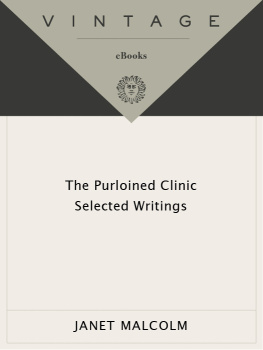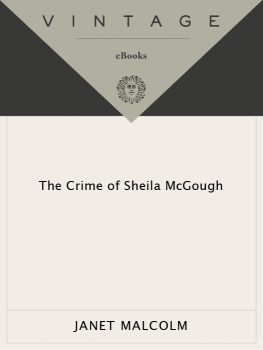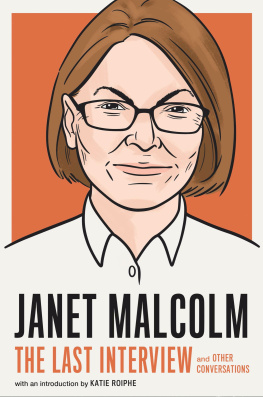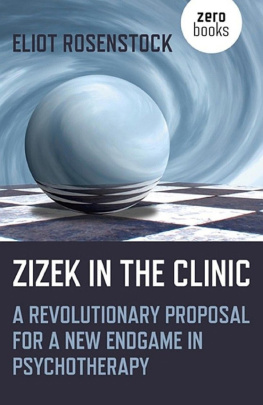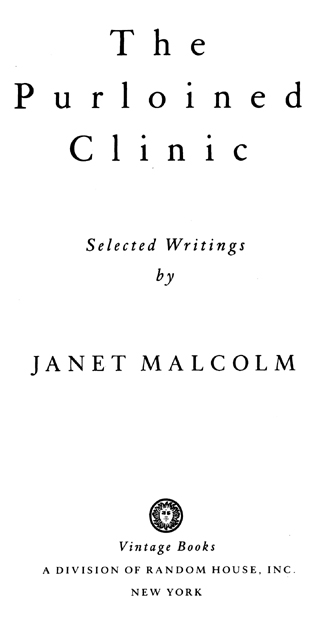Contents
Landmarks
Copyright1992 by Janet Malcolm
All rights reserved under International and Pan-American Copyright Conventions. Published in the United States by Vintage Books, a division of Random House, Inc., New York, and simultaneously in Canada by Random House of Canada Limited, Toronto. Originally published in hardcover by Alfred A. Knopf, Inc., New York, in 1992.
The following pieces originally appeared in The New Yorker, in slightly different form:
The One-Way Mirror (A Reporter at Large), 1978
Six roses ou Cirrhose? (Review of Narrative Truth and Historical Truth by Donald P. Spence), 1983
A Girl of the Zeitgeist (Profile of Ingrid Sischy, parts I and II), 1986
Jappelle un Chat un Chat (now titled Dora) (Reflections), 1987
The Purloined Clinic (Books), 1987
The Window Washer (A Reporter at Large), 1990
Owing to limitations of space, acknowledgments for permission to reprint previously published material may be found on page 385.
Library of Congress Cataloging-in-Publication Data
Malcolm, Janet.
The purloined clinic: selected writings / by Janet Malcolm.
p. cm.
Originally published: New York: Knopf, 1992.
eISBN: 978-0-307-83060-9
I. Title.
[AC8.M315 1993]
081-dc20 93-7859
rh_3.1_c0_r1
Acclaim for JANET MALCOLMS
The Purloined Clinic
Reading [The Purloined Clinic] is a must and a pleasure for those who value a writer of intelligence, grace and clarity, with the daring to write about people and ideas with equal measures of bold originality and quiet reflection.
Baltimore Sun
[Malcolm is] the most dangerous interviewer in journalism Offering dazzling epigrammatic comments on everything from Jacques Lacan to Czechoslovakias Velvet Revolution, Malcolm provokes arguments and shakes things up.
Mirabella
At one point in The Purloined Clinic, Malcolm characterizes a writer like herself as a kind of spy. The direct questions he asks are only a facade behind which the operation of covert watching and listening is mounted; his worklike the work of all spiesis tied to contingency and marked by melancholy. The stoic tenderness of this description suggests at the very least a kinder, gentler spy, whose primary listening device consists of the evenly suspended attention Freud urged upon his pupils.
Village Voice
[Malcolm] lucidly lays out complicated intellectual ideas and sums up her impressions in startling images and metaphors.
The New York Times
Also by JANET MALCOLM
Diana and Nikon
Psychoanalysis: The Impossible Profession
In the Freud Archives
The Journalist and the Murderer
JANET MALCOLM
The Purloined Clinic
Janet Malcolms previous books are Diana and Nikon, Psychoanalysis: The Impossible Profession, In the Freud Archives, and The Journalist and the Murderer. She died in 2021.
To G.B.
Preface
T HE essays, reviews, and reports in this book are a selection from work done largely in the past decade, and almost all were first published either in The New Yorker or The New York Review of Books. The selections reflect what I was thinking and how I was writing at the time, and I leave them in their original state, as the traces of a particular moment. They are arranged in what I hope is a rational and inviting order. But they constitute a miscellany and may be read in any sequence.
The book opens with an essay on Freuds Dora case and ends with a semi-autobiographical report on a trip to post-Communist Prague and an encounter with a Czech-Jewish former dissident, in whom I recognized a sort of double. In between, there are articles and reviews that touch on, among other subjects, the New York art world, family therapy, Bloomsbury, autobiography, architecture, and fiction. I have chosen the title of one of the pieces, a review of Michael Frieds Realism, Writing, Disfiguration: On Thomas Eakins and Stephen Crane, as the title of the collection, because in Fried I recognized another sort of double: a critic whose imagination I found almost uncannily familiar and congenial, and who caused me to see that I had been thinking like a deconstructionist for a long time without knowing it, like Molires M. Jourdain, who discovered that he had been speaking in prose all his life.
I am deeply grateful to Robert Gottlieb, Barbara Epstein, and William Shawn for giving these pieces a home, and for their encouragement and always helpful criticism; to Barbara Bristol and Joan Keener for making the stately process of book publication a great pleasure; and to Mary Quaintance for her sharp-eyed and elegant reading of the final text.
J.M.
Part I
Dora
T ODAY , everyone knowsexcept possibly a few literary theoriststhat the chief subject of the psychoanalytic dialogue is not the patients repressed memories but the analysts vacation. As our therapeutic community grows, as more and more of us participate in the cultural ritual known as going to the shrink, the popular view of psychoanalysis as a kind of surrealistic agon has given way to the less theatrical, more domesticated vision of the analytic encounter as a proving ground for the concept of transference. The patient does not remember anything of what he has forgotten and repressed, but acts it out, Freud wrote in Remembering, Repeating, and Working-Through (1914). He reproduces it not as a memory but as an action; he repeats it, without, of course, knowing that he is repeating it. For instance, the patient does not say that he remembers that he used to be defiant and critical towards his parents authority; instead, he behaves in that way to the doctor. Psychoanalysis is the wary (ultimately weary) examination by patient and analyst of the patients behavior toward the analyst. Out of this absurdist collaborationthe tireless joint scrutiny of the patients reactions and overreactions to the analysts limited repertoire of activity in the sphere of fees, hours, waiting-room etiquette, and, above all, absencescome small, stray self-recognitions that no other human relationship yields, brought forward under conditions of frustration (and gratification) that no other human relationship could survive.
The patient leaves the analysis older, and wiser about analysis. It is finally borne in on him that the object of analysis is not to make sense of his life but to make nonsense of his neurosis. Through repetitive enactment of the neurosis in the transference, the neurosis loses its edge. Psychoanalysis is a process of blunting. From its earliest period, long before Freud knew what he was doing or where he was going, he used the metaphor of wearing away to express the therapeutic effect of the talking cure. Freuds concept of the unconscious is poised on an opposition between the durable and the mutable. What is unconscious is timeless, of stone, forever, while what is conscious is transient, ephemeral, written in water. Freuds early flounderings with hysterical patients, in which, following Josef Breuers flounderings with Anna O., he did what he called cathartic therapy, were posited on the theory that hysteria is caused by forgotten memories of trauma, which have been acting like foreign bodies in the mind. This figure of the oxymoronic irritant appears in Freuds 1897 abstract of earlier writings on hysteria. He continues:

